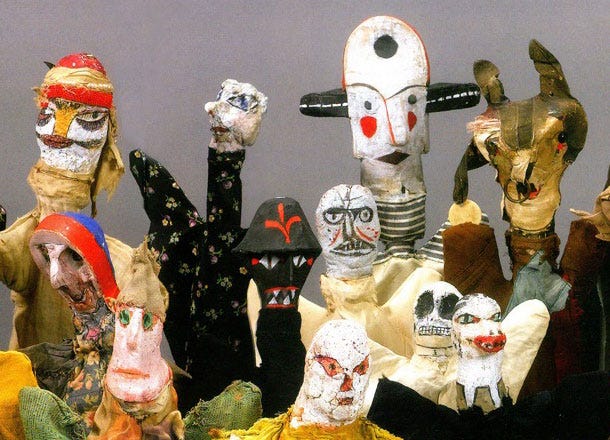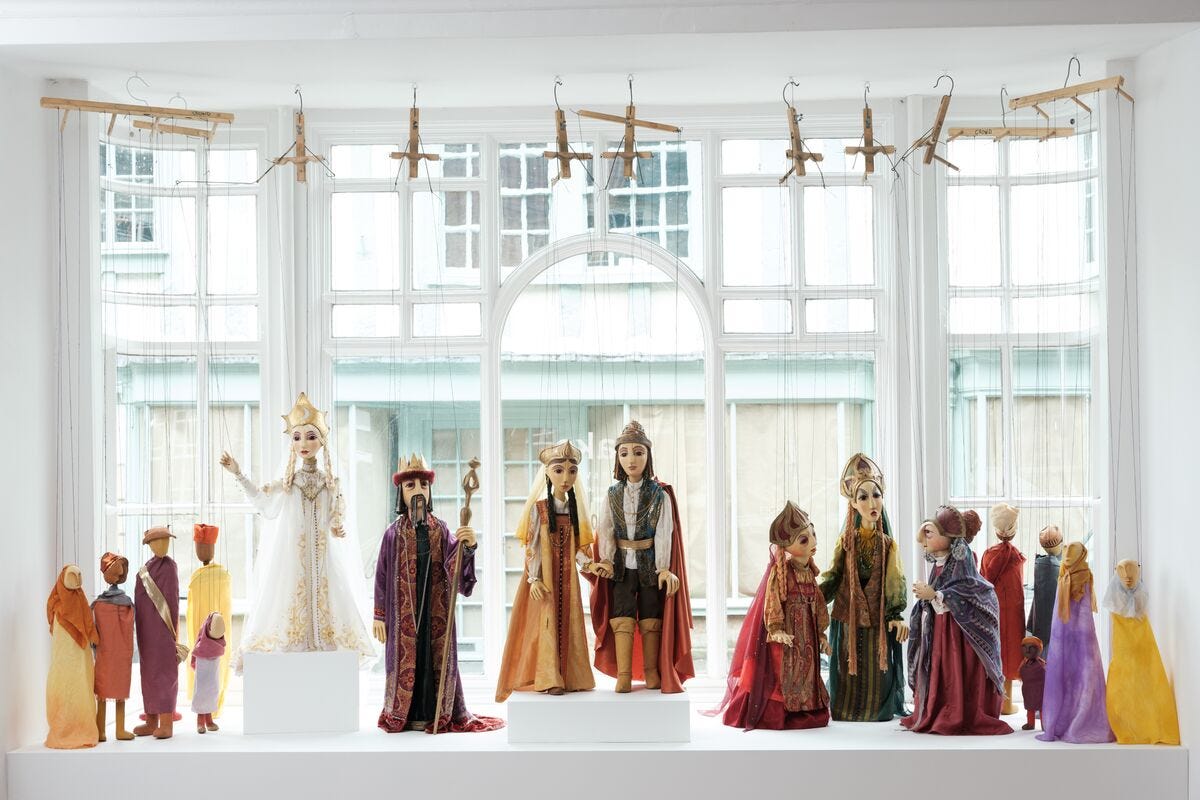A Handful: Puppetry
Legendary Bread + Puppet; traditional Sicilian marionettes; and puppetry performances you don't want to miss
Happy New Year! For those of you who are new here, welcome! And welcome to “A Handful,” in which we gather five newsy-ish tidbits on our craft radar we want to share—announcements, events, inspirations, captivating tangents.
This issue, the through-line is puppetry. For me, puppetry is a beautiful, rare venn diagram that overlaps creative expression, performance art AND traditional craft, spanning the artful craft of making the props and puppets themselves to the audience-engaging performance of the story. In addition the deep folk tradition of vernacular puppetry across the world (the shadow puppets of Indonesia to the water-dancing puppets of Vietnam), there's also a thrilling new trove of contemporary puppets that tickle imaginations and invite new audiences to participate in the wonder and brilliance of the craft. With LA as a cultural bellwether, the beloved Highland Park-based Bob Baker Marionette Theater recently got a brand-new marquee a couple months ago, announcing that it's "In LA to stay!" Reassuring words for puppetry in a time when so many traditional crafts are struggling to find new ways to connect to modern interests and audiences. Below, a handful of puppet and puppet-adjacent exhibitions, performances, and artists, both past and present, working to keep puppetry relevant and exhilarating.
//
Back in mid-September, when it still felt like summer, Vermont's Bread and Puppet came to Detroit to perform in the grassy area beside the Detroit Institute of Arts—and predictably, the eccentric troupe of political puppeteering activists blew my mind. Founded in 1963 in New York City's Lower East Side, Bread and Puppet moved to a farm in Vermont in the 70s, transforming an old hay barn into a museum of sorts for their retired puppets. I still haven't made it to the barn, which now, 50 years later, holds a "a massive accumulation of the puppets, masks, paintings and graphics." It's the kind of unheated, ramshackle-ish place that requires dressing warmly (because there’s no heat), flipping on and off the lights yourself (because there's no docent), and complete and utter reverence (because there’s nothing like it anywhere else). Self-described: “It’s population density is an expression not only of the accumulations of time but of the urgencies which inspired the making of so much stuff: the poverty of the poor, the arrogance of the war-mongers, the despair of the victims, and maybe even stronger than that, the glory of this whole god-given world." The upcoming spring tour starts March 27th and includes more than 25 stops down the East Coast. I guarantee you will be moved/inspired/delighted/angry/motivated/and more all at once. And following in the tradition of the past 50-plus years, there will be homemade bread baked on site and shared with all.
//
In my daughter’s art class, they recently studied and created their own Paul Klee-inspired hand puppets. What a delight! Swiss-born painter Paul Klee, most known for his colorful expressionist paintings and Bauhaus contributions, created a legion of handmade plaster puppets for his son Felix from the scraps of everyday life—clothing remnants, matchboxes, nutshells. Like Calder’s circus (if you’re not familiar, highly recommend the children’s book ROARR by Maira Kalman), Klee made these puppets not for commercial purposes but for pure creative joy. Now, the part of the collection that wasn’t destroyed during World War II lives on at Bern’s Paul Klee Museum. Despite being so willfully strange (the Devil with the Ringed Glove, Electrical Spook, Mr. Death), these eccentric, cobbled-together puppets, made by an artist for his son, create the tenderest of collections.
//
You know puppetry has entered a new dimension when Hauser & Wirth hosts a retrospective for a puppet-maker. We just missed the Hauser & Wirth exhibition in London dedicated to the incredible 60-plus-year career of Lyndie Wright—the high priestess of British puppetry. But if you find yourself in Islington, her studio/workshop— full to bursting with tools and the beautiful mess of an artist at work—and the attached Little Angel Theatre are both open to the public; and her puppeteer daughter Sarah runs the Curious School of Puppetry right next door. The latter offers an eight-week puppetry course as well as a weekly “soup night” for puppeteers, directors, makers, designers, students, historians and enthusiasts.
//
For anyone with plans to travel to Sicily, the puppet scene in Palermo is not a series of tourist traps and mass-produced trinkets; this is real deal traditional craft wizardry representing the age-old tradition of marionettes. Start at the Antonio Pasqualino International Puppet Museum (some 4,000 wide-ranging examples of marionettes, shadow puppets, hand puppets, playbills, and puppets from other countries) for context, where you might catch Salvatore Bumbello, who has been making puppets since he was 11 years old, stage a performances with help from his kids. For a smaller, more niche collection of pupi: the extra-extra-special permanent exhibition, Collezione Giacomo Cuticchio Pupi Siciliani, lives at Palazzo Branciforte. It includes 109 truly next-level pupi from 1830-1960, belonging to the Cuticchio family, who are well-known for their extensive, multigenerational contributions to Sicilian puppetry. Displayed in a magical setting amid the old hand-hewn rafters and wooden stairways of Monte di Santa Rosalia (one of the rare surviving examples of Sicilian wooden architecture), the fantastical collection includes giants, animals, Christian soldiers, pagan soldiers, pageboys, paladins, saracens, as well as hand-painted theatrical scenes and billboards from past performances.
//
Full of the latest and greatest puppeteers from around the world, the Chicago International Puppet Theater Festival starts next week, Jan 15-26. THERE IS STILL TIME TO MAKE PLANS. On the docket: workshops, a puppet /design studio, and of course, the incredible lineup of performances featuring classic and contemporary styles from South Africa, Canada, Chile, China, France, Germany, India, Israel, Italy, Scotland, Norway, Puerto Rico, and the U.S. Many of the shows will be performed more than once. I would most like to see Birdheart (above) and Anywhere, a string-marionette work created by the French company Théâtre de l’Entrouvert.
BONUS HANDFUL (because I can’t help myself):
This spring, Totoro returns to the stage in London for a short-ish run at the Gillian Lynne Theatre. Putting this on your radar, because the puppets, designed by superstar NYC-based third-generation puppeteer Basil Twist are epically fantastical and there will be a mad dash for tickets. Watch him talk about the first time the actors saw the puppets.
And if you happen to be in London for the Totoro show or otherwise, the V&A has a wonderful collection of folk puppets, like this Romanian puppet in traditional dress.
I recently read the children’s book The Puppets of Spellhorst by Kate DiCamillo out loud to my daughter. It’s as magical as it sounds, and if you have a child in your life, I highly recommend.
Did you know that the residents of Santa Fe light a giant puppet named Zozobra on fire every year?
In Slovenia, The Museum of Puppetry/Ljubljana Puppet Theatre houses possibly the most adorable national collection of puppetry ever.
IN CASE YOU MISSED: MORE CRAFT HANDFULS:
A Handful: Ceramics
A Handful: Textiles
A Handful: Baskets
A Handful: Contemporary Take on Traditional Craft










Also in Santa Fe: we just visited the International Museum of Folk Art (the Girard collection) where there is a case of the most amazing Guignol Glove puppets.